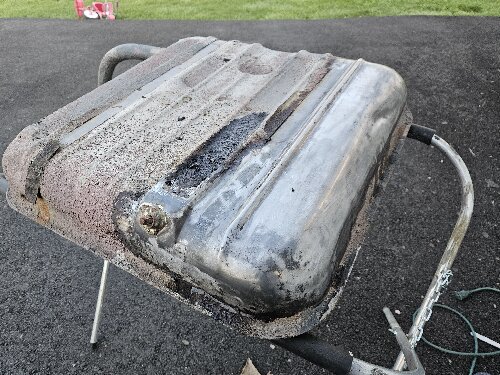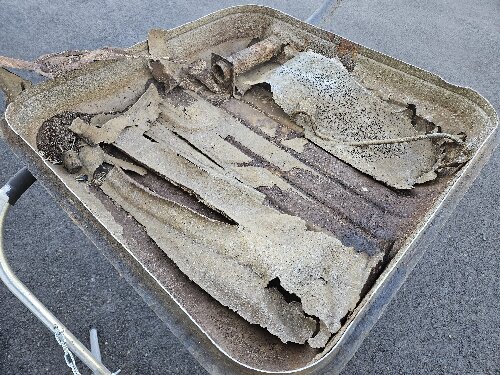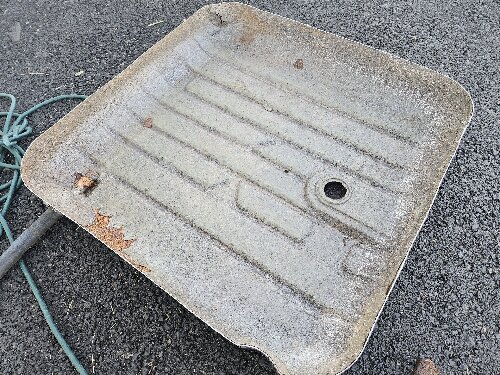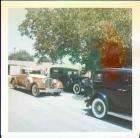|
Re: 51-56' fuel tank internals
|
||||
|---|---|---|---|---|
|
Home away from home
|
The liner looks worse than the tank itself! Was that an earlier sealing job gone bad or from the factory? Once welded back together, can it be done without the seam showing? What did you use to cut it so neatly and evenly?
Posted on: 2024/7/25 21:01
|
|||
|
All generalities are false.
Once I thought I was wrong but I was mistaken. Don Pierson Packard / IMPERIAL page CA DMV Licensed Vehicle VIN Verification 1951 Henney-Packard 3-Door Long Wheelbase Air Force Ambulance The 1951 Henney-Packard is For Sale! 1954 Packard Patrician 1954 Packard Patrician Parts Car 1956 Clipper Custom Sedan |
||||
|
||||
|
Re: 51-56' fuel tank internals
|
||||
|---|---|---|---|---|
|
Home away from home

|
Quote:
I don't think the factory did sealer internally. I have another tank (from my brother in law's '52) that is full of surface rust inside, but no sealer. It is an original tank and the car overall has had much better care than mine. The sealer ended up pooling around the pickup tube area (not covering the intake hole), and was about 3/8" thick in some spots. Pretty bad. For cutting I marked 3/4" above the flange all the way around, then used a cut-off disk on an angle grinder. Took maybe 90 seconds to cut the top off. I'm going to clean up as much of the undercoating as I can, then take it a place to sandblast. Then I'll weld the top back on, seal the interior, and paint the outside. I don't think I can totally hide the weld seam, but at least it will be above the flange and when mounted in the car it shouldn't be very visible. -Kevin
Posted on: 2024/7/25 21:16
|
|||
|
||||
|
Re: 51-56' fuel tank internals
|
||||
|---|---|---|---|---|
|
Home away from home
|
For my 1951 Henney-Packard tank which is quite different and riddled with holes, it ended up with at least three coats of sealer so now it is more of a plastic tank with a steel shell. I managed to minimize the puddling around the pickup tube too but i think the whistle (1951 and earlier only) suffered, Anyway, I used a super-hard silver paint from Hirsch on the outside, roughed it up a bit by hand with sandpaper, they used Hirsch’s aerosol chassis paint over that. No sign of leaks yet but it also has only 5 gallons of petrol in it!
Posted on: 2024/7/26 12:20
|
|||
|
All generalities are false.
Once I thought I was wrong but I was mistaken. Don Pierson Packard / IMPERIAL page CA DMV Licensed Vehicle VIN Verification 1951 Henney-Packard 3-Door Long Wheelbase Air Force Ambulance The 1951 Henney-Packard is For Sale! 1954 Packard Patrician 1954 Packard Patrician Parts Car 1956 Clipper Custom Sedan |
||||
|
||||
|
Re: 51-56' fuel tank internals
|
||||
|---|---|---|---|---|
|
Home away from home

|
I'm trying to get as much of the undercoating off as I can, and man this stuff is tenacious. It's at least 1/4" thick in places and is like partially cured asphalt. The metal underneath it is beautiful though.
Does this stuff come off with sandblasting? I figured I would save them some time by doing it myself. But maybe sandblasting would get it quicker? Not sure because the stuff isn't "hard". 
Posted on: 2024/7/26 15:40
|
|||
|
||||
|
Re: 51-56' fuel tank internals
|
||||
|---|---|---|---|---|
|
Forum Ambassador
|
I believe the original tank was terne steel sheetmetal which has an inner coating consisting of an alloy of tin and lead which minimizes corrosion a bit more effectively than ordinary zinc galvanizing. Moisture can still affect it over time though as evidenced by the many rusted out tanks. If you sandblast you will remove whatever is left of that terne coat and to avoid almost instant rusting the cleaned tank will need to be quickly sealed again hopefully using a better product than used for the current sealing.
Posted on: 2024/7/26 16:07
|
|||
|
Howard
|
||||
|
||||
|
Re: 51-56' fuel tank internals
|
||||
|---|---|---|---|---|
|
Webmaster
|
The "Renu" process uses an epoxy coating that is then baked on. Both inside an out. It produces a hard coating.
Which for me was a better choice then "pour-in" style sealers that can fail and clog the inlet, or stories of the sealer puddling when adding and sealing the inlet. Those produce more of a rubbery coating.
Posted on: 2024/7/27 8:43
|
|||
|
-BigKev
1954 Packard Clipper Deluxe Touring Sedan -> Registry | Project Blog 1937 Packard 115-C Convertible Coupe -> Registry | Project Blog |
||||
|
||||
|
Re: 51-56' fuel tank internals
|
||||
|---|---|---|---|---|
|
Home away from home

|
Howard - I'm hoping that the sandblasting will be like when I had the interior of my car sandblasted. The metal stayed clean for months while I did cutting and welding, etc. No surface rust whatsoever by the time I sprayed it with epoxy. As long is stays clean long enough for me to weld and seal then I'll be good.
Kev - The Renu process is great. But with reproduction tanks readily available for the '51-56 cars it's not really needed. The only reason I'm trying to salvage this tank is because I have two old tanks sitting at my house collecting dust, and I'd like to have a spare tank without spending much money. I'll have to try and get the sealer to not puddle....we'll see how that goes. -Kevin
Posted on: 2024/7/27 9:48
|
|||
|
||||
|
Re: 51-56' fuel tank internals
|
||||
|---|---|---|---|---|
|
Home away from home
|
Won't hurt to wipe the inside down with motor oil as an anti rust.
Posted on: 2024/7/27 10:29
|
|||
|
1955 400 | Registry | Project Blog
1955 Clipper Deluxe | Registry | Project Blog 1955 Clipper Super Panama | Registry Email (Parts/service inquiries only, please. Post all questions on the forum.) service@ultramatic.info |
||||
|
||||
|
Re: 51-56' fuel tank internals
|
||||
|---|---|---|---|---|
|
Home away from home
|
Rust on fresh, blasted metal won’t be visible for quite a while but starts forming immediately so I would always uses Ospho to better protect things like that. It adds a phosphate coating that can be painted over.
On the tank, while BigKev, doesn’t like pour-ins, I use the Hirsch sealer and have used it for decades with gasoline recently drained after sitting for close to 40 years still smelling like gasoline. On the Henney-Packard tank that I did recently, the Hirsch kit wasn’t to helpful and their etcher did not do a good job but Ospho did, then the Hirsch sealer purchased by the gallon finished it off. Renu, or a very similar process, was used on my 1965 Cadillac Fleetwood’s tank and it seems to he holding up well so far but the process requires a large opening to be cut into the tank. Of course, with your tank already opened up and cleaned, that would not be necessary.
Posted on: 2024/7/27 14:24
|
|||
|
All generalities are false.
Once I thought I was wrong but I was mistaken. Don Pierson Packard / IMPERIAL page CA DMV Licensed Vehicle VIN Verification 1951 Henney-Packard 3-Door Long Wheelbase Air Force Ambulance The 1951 Henney-Packard is For Sale! 1954 Packard Patrician 1954 Packard Patrician Parts Car 1956 Clipper Custom Sedan |
||||
|
||||










